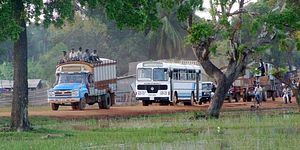While last month’s Easter Sunday bombings and their aftermath refocused international attention on Sri Lanka, there has only been passing mention of the country’s previous history of armed conflict that concluded on May 18, 2009, often with a failure to appreciate the fact that this did not end the ethnic tensions therein. On the tenth anniversary of the cessation of hostilities, members of the international community must understand that delivering accountability for mass atrocities is an essential element of dealing with root causes of conflict.
On May 18, 2009, the Sri Lankan government declared an end to a 26-year-long armed conflict after committing mass atrocities, including allegations of genocide. The atrocities are well-documented, and the military’s intentional shelling of government-designated “No Fire Zones” (NFZs) alone was primarily responsible for killing 70,000–140,000 Tamil civilians, maiming another 25,000–30,000, and displacing at least 300,000.
But for many Tamils in the North-East and diaspora, May 18 this year not only marks the conclusion of the armed struggle for self-determination led by the Liberation Tigers of Tamil Eelam (LTTE), but also a decade without justice for crimes that had been committed. Although Tamils had varying views about the LTTE’s tactics, for many, its military defeat represented an end to the hope that Tamils would be free from successive Sinhala-Buddhist nationalistic regimes that had sponsored anti-Tamil pogroms with impunity at various points since independence.
Since May 18, 2009, the United Nations and states have acknowledged that Sri Lanka’s violations of international human rights law and international humanitarian law may amount to war crimes and/or crimes against humanity in a court of law. Despite facts and jurisprudence strongly supporting a legal finding of genocide, however, the same entities have shied away from even using the word “genocide” concerning the atrocities against the Tamil people.
A cursory review of the evidence indicates the Sri Lankan government’s intent to destroy the Tamil people, a protected ethnic and national group. The government had a clear and effective strategy of encouraging Tamil civilians in the Vanni region to relocate to the “No Fire Zones” that were then deliberately shelled by the military. It also purposefully understated the number of Tamil civilians in the Vanni to limit necessary food and medical supplies going into that area and to facilitate the deaths of survivors. Hundreds of Tamil women and girls were raped and sexually mutilated before their execution. Tamil men and women who were detained after crossing into government-controlled areas are still subjected to sexual violence today.
Survivors’ trauma has been exacerbated by an endless wait for a court to validate the harms they suffered by adjudicating that “genocide” occurred. This is particularly insulting in light of the government’s continual rejections of agreed-upon UN Human Rights Council commitments to establish a special court with foreign judges, lawyers, and investigators, in addition to the absence of other paths to justice.
However, a court finding is not necessary to politically recognize genocide. In fact, UN guidance encourages UN actors and states to acknowledge when violations of international law may amount to atrocity crimes, regardless of the existence of legal determinations. An assessment of established risk factors and indicators of war crimes, crimes against humanity, and/or genocide provides guidance on when atrocities may be appropriately deemed “genocide.”
Whenever there is a serious risk of genocide, members of the international community have a responsibility to prevent it and punish the perpetrators. In Sri Lanka, however, the UN withdrew from the warzone around September 2008, thus enabling the genocide. After internally reviewing its inaction in 2012, the UN determined it committed a “systemic failure.” By February 2019, few lessons had been learned and the UN had to revisit its shortsightedness in Sri Lanka in the hopes of understanding how it subsequently ignored signs of Myanmar’s atrocity crimes against the Rohingya. Notably, although some UN actors have recognized the Rohingya genocide, they have maintained their silence on the Tamil genocide.
Given their failures and desire to demonstrate that lessons can be—and have been—learned, the UN owes it to the Tamil people, who were subjected to state-sponsored genocide, to appropriately characterize Sri Lanka’s mass atrocities. It must also explore and open alternative, parallel paths to justice.
In other states with similar levels and cultures of impunity, such as Syria and Myanmar, the UN General Assembly and the UN Human Rights Council respectively established mechanisms to collect, preserve, and analyze evidence for criminal justice purposes. This does not relieve the UN Security Council of the responsibility to refer the situation in Sri Lanka to the International Criminal Court, a still unlikely prospect. Tamil activists are increasingly calling for such alternative, parallel avenues to see justice served for the Tamil people.
As the window for transitional justice narrows, the hopelessness and frustration of Tamil genocide survivors must be prioritized over six years of the government’s false promises. Given Sri Lanka’s utter lack of political will to investigate and prosecute atrocity crimes in accordance with international commitments, members of the international community must promptly act to ensure the punishment of perpetrators and the precise recognition of all atrocity crimes committed against the Tamil people, including genocide.
Anjali Manivannan is the Senior Legal Analyst with People for Equality and Relief in Lanka (PEARL).

































